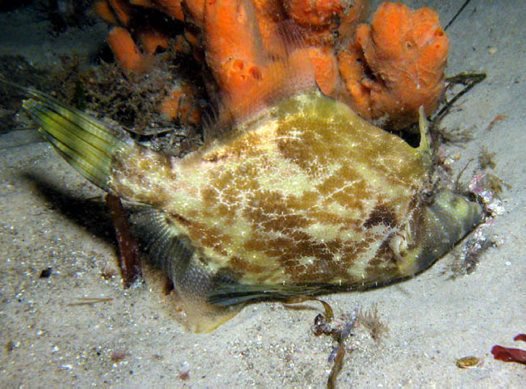Why are they called triggerfishes?
On this page...
Triggerfishes (Balistidae) and leatherjackets (Monacanthidae) have a first dorsal fin spine that can be locked into an erect position.

© Australian Museum
This is made possible by a ball and socket "trigger-like" mechanism. The base of the second spine slots into a groove in the first spine. The locking mechanism is released when the second spine is depressed.
Many triggerfishes and leatherjackets also have a shaft-like pelvic bone (visible in the following image) that can be lowered to stretch out the dewlap, a sail-like flap of skin (see bottom image).

© Dave Harasti

A Potbelly Leatherjacket, Pseudomonacanthus peroni, at a depth of 18m, Bundaberg Artificial Reef, Queensland, August 2004.
Image: Dave Harasti© Dave Harasti
Young triggerfishes and leatherjackets can use the locked dorsal fin in combination with the lowered pelvic bone to wedge themselves into crevices.
Locking the first dorsal fin spine and lowering the pelvic bone makes an adult fish look larger and may discourage potential predators.
Further reading
- Helfman, G.S, Collette, B.B. & D.E. Facey. 1997. The Diversity of Fishes. Blackwell Science. Pp. 528.
- Matsuura, K. & J.C. Tyler. in Paxton, J.R. & W.N. Eschmeyer (Eds). 1994. Encyclopedia of Fishes. Sydney: New South Wales University Press; San Diego: Academic Press [1995]. Pp. 240.

